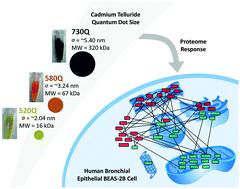当前位置:
X-MOL 学术
›
Toxicol. Res.
›
论文详情
Our official English website, www.x-mol.net, welcomes your feedback! (Note: you will need to create a separate account there.)
Cadmium telluride quantum dot-exposed human bronchial epithelial cells: a further study of the cellular response by proteomics.
Toxicology Research ( IF 2.1 ) Pub Date : 2019-10-22 , DOI: 10.1039/c9tx00126c Yan-Ming Xu 1 , Heng Wee Tan 1 , Wei Zheng 1 , Zhan-Ling Liang 1 , Fei-Yuan Yu 1 , Dan-Dan Wu 1 , Yue Yao 1 , Qiu-Hua Zhong 1 , Rui Yan 1 , Andy T Y Lau 1
Toxicology Research ( IF 2.1 ) Pub Date : 2019-10-22 , DOI: 10.1039/c9tx00126c Yan-Ming Xu 1 , Heng Wee Tan 1 , Wei Zheng 1 , Zhan-Ling Liang 1 , Fei-Yuan Yu 1 , Dan-Dan Wu 1 , Yue Yao 1 , Qiu-Hua Zhong 1 , Rui Yan 1 , Andy T Y Lau 1
Affiliation

|
Quantum dots (QDs) are luminescent nanoparticles with superior versatility. In this regard, cadmium telluride (CdTe) QDs have been widely used for various bioimaging applications. Although these nano-Cd containing particles can be capped with shells to reduce their cytotoxicity, these shells would be gradually disintegrated after a certain period of time, thereby inevitably exerting nanotoxicity. Previously, we showed that treatment of human bronchial epithelial BEAS-2B cells with uncapped CdTe QDs (520Q, 580Q and 730Q with emission maximum at 520, 580 and 730 nm, respectively) elicited dose-dependent cytotoxicity for 520Q and 580Q (<5 nm), while 730Q (>5 nm) elicited negligible cytotoxicity. In order to gain a more global perspective on the action mechanism of these nano-Cd particles, here, we further characterized the proteome response of BEAS-2B when challenged with the above QDs. Interestingly, among the three nano-Cd particles, we observed that 520Q and 580Q treatment altered the BEAS-2B proteome significantly in a very similar magnitude while 730Q has no obvious impact at all, as compared with the untreated control. Notably, the treatment of BEAS-2B with glutathione before nano-Cd particles abrogated the induction/repression of differentially expressed proteins and prevented cell death. Taken together, our findings show that uncapped CdTe nanoparticles (520Q and 580Q) induce oxidative stress in human bronchial epithelial cells, and the similarly altered protein signatures also suggest potential mitotoxicity and common cellular and detoxification responses upon exposure of lung cells to these two QDs. On the other hand, 730Q may exert a more noticeable effect after long-term exposure, but not upon transient exposure.
中文翻译:

碲化镉量子点暴露的人支气管上皮细胞:蛋白质组学对细胞反应的进一步研究。
量子点(QD)是具有出色多功能性的发光纳米粒子。在这方面,碲化镉(CdTe)QD已广泛用于各种生物成像应用。尽管可以用壳覆盖这些包含纳米Cd的颗粒以降低其细胞毒性,但在一定时间后这些壳将逐渐崩解,从而不可避免地发挥了纳米毒性。以前,我们表明用未封端的CdTe QD(520Q,580Q和730Q分别在520、580和730 nm处有最大发射)处理人支气管上皮BEAS-2B细胞引起了520Q和580Q(<5 nm)的剂量依赖性细胞毒性),而730Q(> 5 nm)引起的细胞毒性可忽略不计。为了更全面地了解这些纳米Cd粒子的作用机理,在这里,我们进一步表征了当受到上述QD挑战时BEAS-2B的蛋白质组反应。有趣的是,在三个纳米Cd颗粒中,我们观察到520Q和580Q处理与未处理的对照相比,以非常相似的幅度显着改变了BEAS-2B蛋白质组,而730Q则根本没有明显的影响。值得注意的是,在纳米镉粒子之前,用谷胱甘肽对BEAS-2B的处理废除了诱导/抑制差异表达的蛋白质并防止了细胞死亡。综上所述,我们的发现表明,未封端的CdTe纳米粒子(520Q和580Q)在人支气管上皮细胞中诱导氧化应激,并且类似变化的蛋白质特征还表明,当肺细胞暴露于这两个QD时,潜在的线粒毒性以及常见的细胞和排毒反应。另一方面,
更新日期:2019-10-22
中文翻译:

碲化镉量子点暴露的人支气管上皮细胞:蛋白质组学对细胞反应的进一步研究。
量子点(QD)是具有出色多功能性的发光纳米粒子。在这方面,碲化镉(CdTe)QD已广泛用于各种生物成像应用。尽管可以用壳覆盖这些包含纳米Cd的颗粒以降低其细胞毒性,但在一定时间后这些壳将逐渐崩解,从而不可避免地发挥了纳米毒性。以前,我们表明用未封端的CdTe QD(520Q,580Q和730Q分别在520、580和730 nm处有最大发射)处理人支气管上皮BEAS-2B细胞引起了520Q和580Q(<5 nm)的剂量依赖性细胞毒性),而730Q(> 5 nm)引起的细胞毒性可忽略不计。为了更全面地了解这些纳米Cd粒子的作用机理,在这里,我们进一步表征了当受到上述QD挑战时BEAS-2B的蛋白质组反应。有趣的是,在三个纳米Cd颗粒中,我们观察到520Q和580Q处理与未处理的对照相比,以非常相似的幅度显着改变了BEAS-2B蛋白质组,而730Q则根本没有明显的影响。值得注意的是,在纳米镉粒子之前,用谷胱甘肽对BEAS-2B的处理废除了诱导/抑制差异表达的蛋白质并防止了细胞死亡。综上所述,我们的发现表明,未封端的CdTe纳米粒子(520Q和580Q)在人支气管上皮细胞中诱导氧化应激,并且类似变化的蛋白质特征还表明,当肺细胞暴露于这两个QD时,潜在的线粒毒性以及常见的细胞和排毒反应。另一方面,


























 京公网安备 11010802027423号
京公网安备 11010802027423号